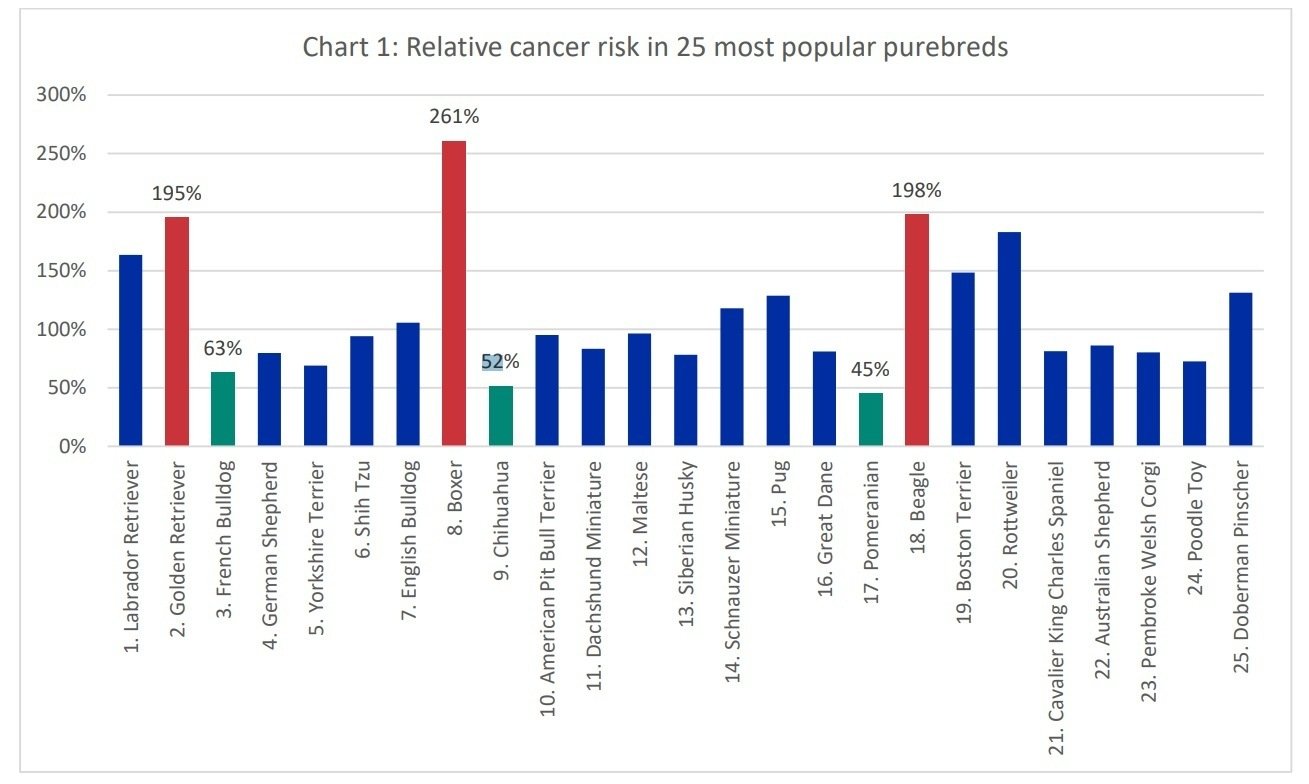In March 2022, Nationwide Veterinary Analytics published the second of three white papers with important data on canine cancer risk. Here’s a video that speaks through the headlines, showing the main charts and much of the same information in the text below as well. They focused on the top 25/most popular dog breeds, so many of us don’t get information for our own dog breeds. It’s very interesting nonetheless. Let’s take a look at what we’ve learned.
More…
^^ Sorry, the text in the video is a bit pixelated. I didn’t want the file to be huge so I saved it in lower quality. Lesson learned I think.
March 2022 – Cancer risk data
In March 2022, Nationwide® Veterinary Analytics released a white paper with data on the relative risk of pet cancer insurance claims broken down by:
- Breed
- Dog breed + affected body system
- Dog breed + age of initial application
You can download and read the announcement, whitepaper, and details on the methodology and math.
petinsurance.com/veterinarians/research/

Relative cancer risk data in dogs
Prior to writing this white paper, Nationwide® Veterinary Analytics conducted a single variable analysis of pet insurance claims:
- 1.61 million dogs
- 6 years between 2015 and 2021
- Purebred dogs make up about 60% of the dogs studied.
Then they looked at additional details of the top 25 breeds represented in this dataset. Almost 70% of all federally insured purebred dogs are in the top 25 breeds [sample size of at least 10,000 dogs across the sample period].
- Labrador Retrievers
- Golden retriever
- French bulldog
- German shepherd dog
- Yorkshire terrier
- Shih Tzu
- English bulldog
- boxer
- chihuahua
- American pit bull terrier
- Dachshund / Miniature
- Maltese
- Siberian husky
- Schnauzer / Miniature
- pug
- German Mastiff
- Pomerania
- beagle
- Boston terrier
- rottweiler
- Cavalier King Charles Spaniel
- Australian Shepherd
- Pembroke Welsh Corgi
- Poodle / Toy
- Doberman Pinscher
Which means relative risk
Basically, the relative risk provides a comparison with the cancer damage rates for the average of all dogs. If all dogs have a relative risk of 1.0 or 100% then all:
- Higher than 1.0 or 100% means a higher relative risk
- Below 1.0 or 100% represents a lower relative risk
Relative Risk Warnings/Limitations
To help us understand what the white paper says and doesn’t say, Nationwide® Veterinary Analytics states… “These relative risk scores support the likelihood that dogs of this breed have had at least one cancer claim. They do not infer the general health of the breed, the severity of any cancer, or the effect of these cancer data on a breed’s longevity.”
The big headlines – data on cancer risk in dogs
“As a group, purebred dogs make up approximately 60% of the dogs studied, with an overall rate of cancer cases nearly twice that (189% or 1.9 times) that of non-pedigree dogs.”
3 breeds with the highest relative risk
- Boxer – 261% relative risk
- Beagles – 198% relative risk
- Golden Retriever – 195% relative risk
However, since the overall relative risk for purebred dogs is 189%, this data stands out more for Boxers than the others at the top.
3 breeds with the lowest relative risk
- French bulldogs – 63% relative risk
- Chihuahuas – 52% relative risk
- Pomeranian – 45% relative risk

Relative risks for boxers by body system
- Skin tumors – 420% relative risk
- Heart – 462% relative risk
- Lymphatic – 357% relative risk
- Neurological – 492% relative risk
Beagles Relative Risks by Body System
- Urinary – 632% relative risk – Apparently, beagles often get bladder cancer.
- Endocrine – 264% relative risk
- Liver – 333% relative risk
- Breast – 234% relative risk
- Spleen – 242% relative risk
Goldens Relative Risks by Body System
These spleen and heart dates (common sites for hemangiosarcoma to occur) are not at all surprising in Goldens.
- Spleen – 320% relative risk
- Bone – 235% relative risk
- Heart – 420% relative risk
- Liver – 280% relative risk
- Lymphatic – 265% relative risk

Rottweiler News! Oof! Our Rottie friends have a 1,009% relative risk of bone cancer. This means they are 10 times more likely to develop bone cancer compared to the average dog.
However, their overall relative risk of cancer is 81% because the risk of cancer is lower “in almost every other body system”.
Youngest breeds for age of first claim
- Boxer (7.6 years)
- Rottweiler (7.8 years)
- Doberman (7.4) years
Driven by several factors, most notably “body systems most commonly affected by cancer in these breeds”

This big chart sums it all up.

Note that the earliest cases of cancer occur at 6.2 years of age in Great Danes and 6.8 years of age in French Bulldogs. This means we really need to watch our dogs and alert our veterinary teams to changes from around 6 or 7 years of age.
Post a comment if something in the data surprised you.


